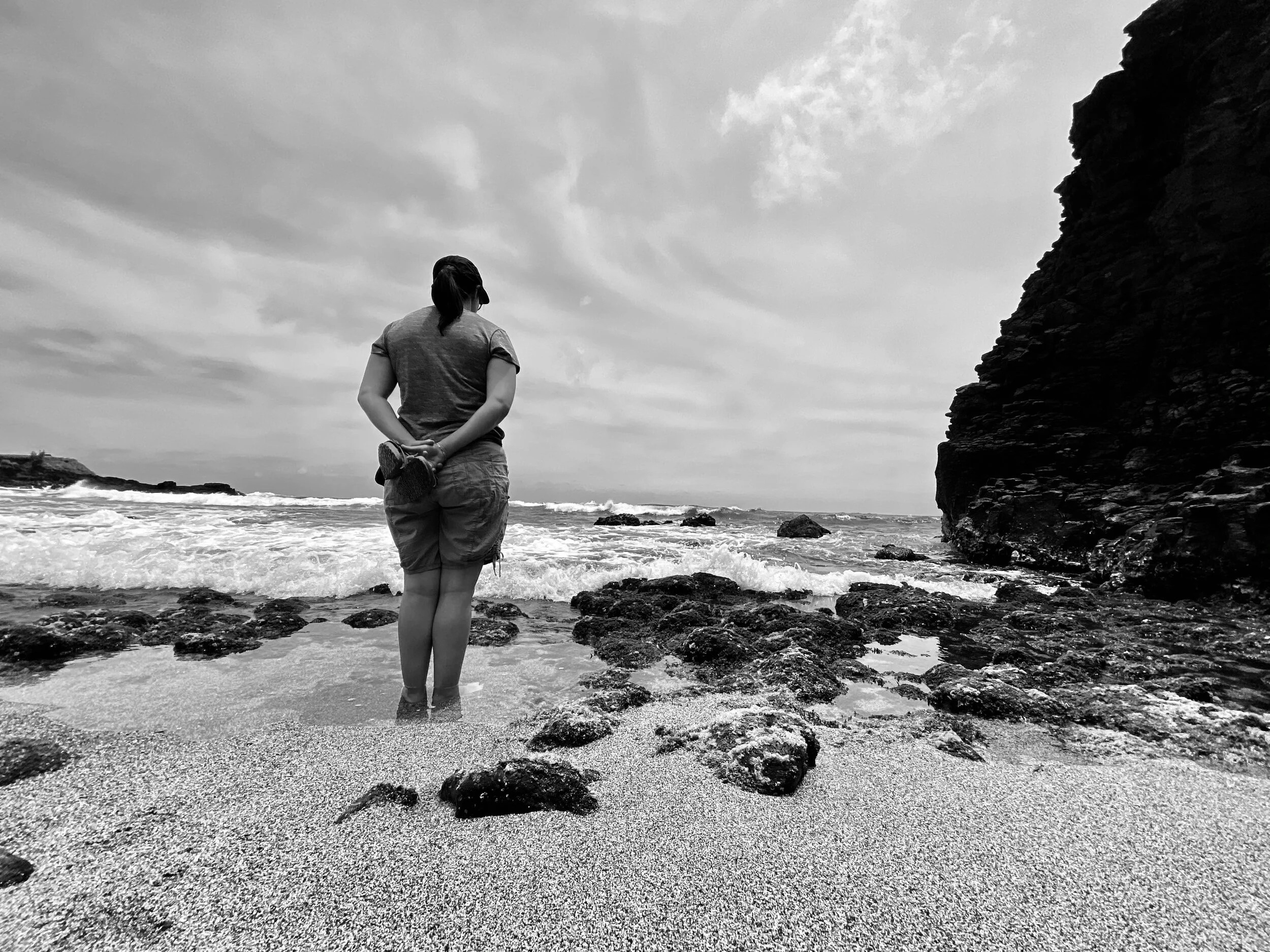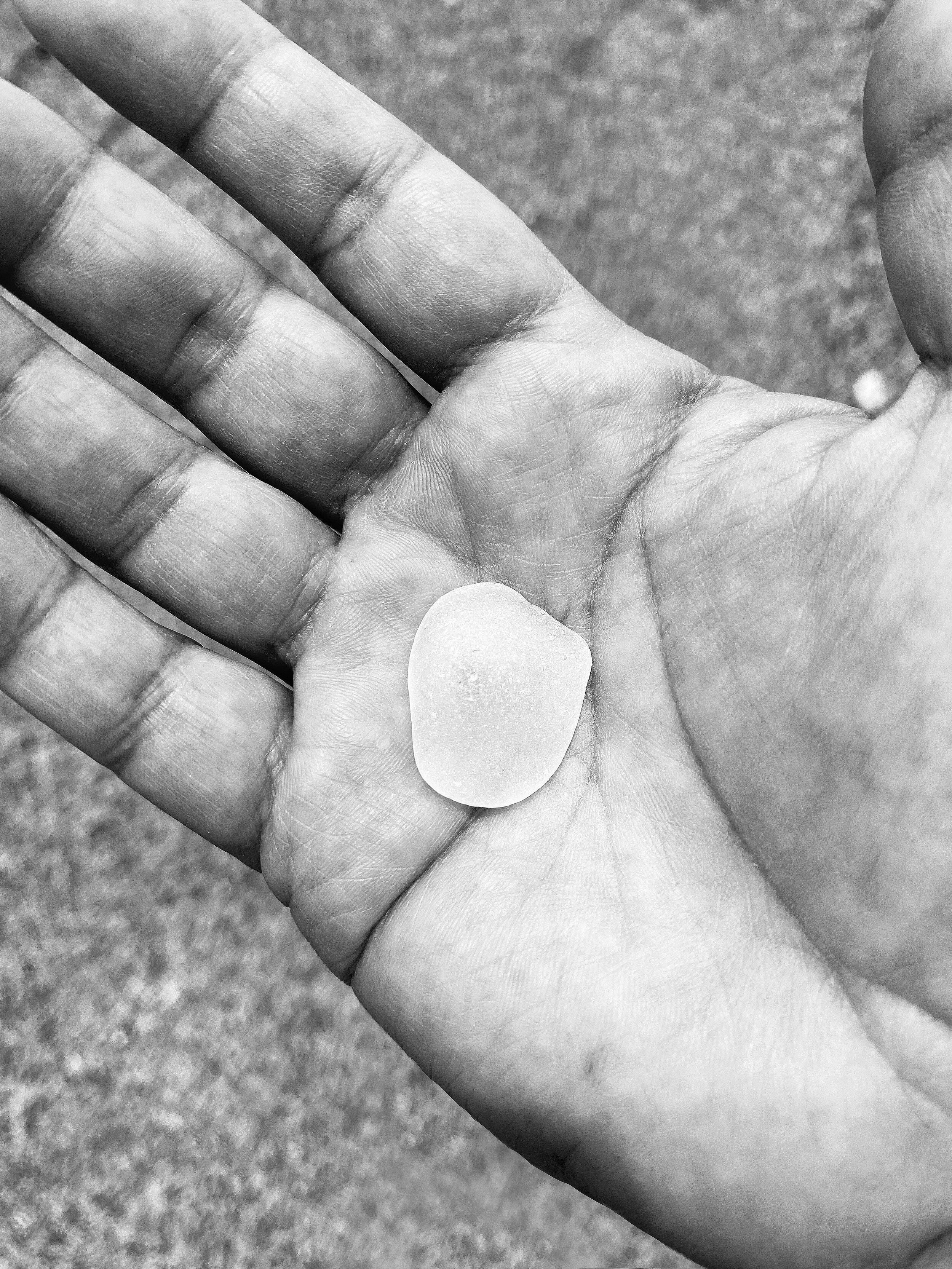The Disappearance of Beach Glass in Hanapēpē

A local throws a glass Heineken bottle onto the reef over into the shore break.
It shatters against stone, its clinks muffled by the white wash that breaks over it, sweeping its shards to sea. Over time, the label peels off. The thin business card-sized patch of adhesive dissolves into the Pacific. The tides brush the glass pieces over sand and rock. Decades pass. The shards of glass are now frosted and rounded, like Halls drops, and sit absorbing sunlight along the shoreline. Luminescent pebbles of time. The entire beach shimmers with broken things—kernels of Heineken bottles, bud light bottles, old coke bottles. All vintage and time worn.
A tourist, having read an article in a travel magazine about this old cove tucked away next to an old sugar plantation cemetery past Port Allen, picks these little gems from the sand. And that same local, the one who decades ago had carelessly thrown the glass bottle into the ocean, laments the removal of this single frosted nugget.
“The tourists plunder everything, even our trash.”
Now that’s paraphrasing our sentiment, but I’m sure those very words have been spoken by someone, even my dad at one point or another. My dad, who in his youth was likely to have been one of those beach drinkers who tossed his bottle years before he and my mom had their first date along the pier at Port Allen. Hell, I may have done the same thing decades later.
I was happy to meet Stanley one December years ago. He was 78. A short Japanese guy with a white beard wearing a big trucker cap that gave him the proportions of a kid with the outfit to boot—t-shirt, surf shorts, and rubber slippers that scuffed and clucked along his feet as he strolled along the center lines of Hanapēpē road.
I had flown in from O‘ahu, having volunteered for this photo assignment and writing assignment for a free ticket to go see my folks who lived nearby. I was waiting around at what looked like an abandoned house along the bend, its outer walls of green peeling paint were as weathered as the lichen-covered bark of an avocado tree. This was the Taro Ko Chip Factory, and it had suddenly become popular among visitors and locals alike. Its plantation home-in-disrepair-chic was part of its charm. I had already been turned away by the younger guy inside who told me that he wasn’t the guy to talk to. He just did the cooking. Stanley was the talker. And here he came walking down the street like a teenager who had just slurped up a bowl of Sapporo Ichiban instant ramen for lunch, drumming his stomach.
He was a short guy, thin-framed and light on his feet. He was once featured on the news just as the shop was gaining in popularity among visitors. In the interview, he picked up a Coors Light and said “This is my vitamin B,” then pointed to a Crown Royal bottle and said “That is my vitamin C. I take them every day,” and laughed.
“Stanley?” I asked.
“Yeah,” he confirmed.
“Your partner just asked me to talk to you. I’m with a travel pub, wanted to take some photos of your taro chips. Maybe get an interview. Get some process shots.”
“Hah?”
“I’m with a magazine.” I stepped out of the way and he walked up the steps and pulled open the screen door. Inside his partner was deep-frying paper-thin strips of taro in a wok over a propane ring. The space was a gutted living room, it seemed. Its window sills were lined with empty Crown Royal bottles. On a small table near the front door were five cardboard boxes all carrying bags of chips for four bucks apiece. And that was it. Behind him was what appeared to be an excavated bedroom, shelves stacked with bric-a-brac, cardboard boxes, empty beer bottles.
“No, no. Too many tourists!” Stanley exclaimed. “One ‘nother magazine wen’ write about us. And then, ho! Plenny tourist! And you know them, they no mo yosha, you know. They buy everything. Only kuzu left. We up all night making da chips, and then we run out by 11 and gotta close! No can, that kine!”
“Good though, yeah?” I asked, falling back into a good Japanese-style pidgin cadence that felt like home.
“Not good. No like go home THAT early,” he said.
“You guys can expand. Scale up?”
“No, no. Just like this enough. We not greedy.”
We talked for a bit, and he asked me where I was from. I told him I grew up in Lāwa‘i then moved to Hanapēpē , then off to Honolulu for college.
“What’s your last name?” he asked. It’s a question I get a lot when people from Kaua‘i are trying to figure out my social circle. Usually, they try to align my last name with another, as if each name existed on a star wheel. Hmm, do you know the Garmas? they would ask, because they knew a Nakamura who knew a Garma. And these Garmas must have been great Garmas, because all the Nakamuras knew them, I supposed. I usually disappointed them.
But here, my last name brought up another familiar name. “Nakamura?” He asked. “You know one Richard?”
“Yeah! Well, he was my uncle. Passed away a long time ago. My dad is Wally.”
Stanley lit up. “Wally!”
I was surprised that at what seemed at first an abandoned home, the kind that homeless people would squat in, was at some point in the 70’s a hopping saimin joint called the Oganeko Saimin Stand. And that Stanley and my dad had known each other and hung out there as a part of the same circle. He told me of stories of their younger days, and a picture of my dad as a younger brother and tagalong emerged. “Me and Richard use to let Wally come with us,” he laughed. “We use to make fun. We used to go bowling, we used to go drinking, we do this, do that, and he always follow. That Wally, how he stay?”
“Good,” I answered. “Living in Ele‘ele. Retired.”
“Tell em come see me!”
A guy in a Toyota Tacoma rolled up and called Stanley from outside. He got out with a 24-pack of Bud Lights and handed it to Stanley. “Merry Christmas. Drink up,” he said, got back into his truck and drove off. Stanley took the case and put it in a back room where a relic of the original saimin shop’s menu board still hung on the wall, advertising a regular saimin for $1.50, and a burger for $1.00.
“So what, can?” I asked, holding up my camera.
“Hah? Oh, yeah yeah, can. Just no make da picture too big. We no like too much people coming fo’ buy everything. The tourists, they take everything. Gotta save some fo’ everybody.”
Back then he was a lively 78-year-old.
I was in the process of selling out my island — photographing and writing about tourist spots for a travel publication on Kaua‘i, using my parents’ home as home base. I was revisiting haunts I had known as a kid growing up in Lāwa‘i and snapping away for potential visitors. I was pitching them with every word I wrote in the captions. “Nestled.” “Shimmering.” “Grandeur.” Allerton Gardens, Poipu beach, the 88 Buddhist shrines found at the site of a heiau. Snap, snap, snap.
I was reminded of a short story about the Roman Colosseum becoming more and more translucent by the year. As tourists snapped photos, they took just a little of bit of it with them, leaving a little less behind. By the end of the story, the colosseum was a faint and ghostly visage behind a scrim of grey haze. I looked at my camera sitting beside me in the front seat of my rented Honda and wondered how much I was taking. How much of this plundering was I promoting to would-be visitors with iPhones and DSLR’s?
The salt ponds, the Hanapēpē swinging bridge that led to a small sign across the river that says “Turn around, locals only.” The Waimea pier where as kids we lowered crab traps and went fishing. Even glass beach where a hand-painted sign posted high atop a tree reads “Please show Aloha and don’t steal the glass.” Snap, snap, snap.
“They get you working hard, ah?” My dad said one night over dinner.
“Well, they paid for the flight and car rental,” I answered.
“But you gotta work the weekend like this? No could fly in on Monday?”
He was right.
My Dad was a vet, a former business owner, husband and father of my brother and myself. He traveled the world after high school for seven years in the army, then started J&W Auto Parts when he returned. When he proposed to my mom, he promised her that she wouldn’t have to worry about the fact that she was a foreigner who understood little English and followed through. He worked himself to the bone, saved up and bought the lot in Hanapēpē. And over the course of two years, we built our home, working after school and on weekends. Through it all, he was kind, but quiet and stern. A smaller reticent guy, who didn’t quite fit in with his bigger, more boisterous peers as he went from the owner of his own auto-parts store, then to a lumber yard after hurricane Iniki devastated his business, then to Napa Auto Parts where he retired. In the arc of his life, he sent my brother and me to college, became a granddad, and left my mom the house she lives in free and clear. When he died, he left us spinning for a sense of who he was. “I never heard that story,” became a frequent comment.
“You better take it easy,” he continued, echoing the sentiment that my wife, then-girlfriend, Rachel, been reiterating to me late dinner after late dinner.
I changed the subject. “I went to the taro factory and there was this guy named Stanley. You know him?”
“Who?”
“Stanley from Taro Ko Factory.”
“Stanley?” He looked off into the distance, then snapped his head back as if Stanley had just jumped into view a few inches from him. “Ah! Yeah, Stanley. That was my braddah’s friend,” he deflected, then turned on the television.
It’s been years since my Dad’s death, and a year since the pandemic started. The tourism industry had gone through a near-death experience and was in a form of rehab — wiggling its toes, learning to support its own weight again. My mom, who had been furloughed from the tourist shop she had worked at for 20 years, was just called back to work a couple of days a week.
She had always worked with her hands, having been a seamstress and business owner herself in Japan until she moved to Hawai‘i in her early twenties, working for the ‘Iolani Sportswear company in the 1970’s, then as jewelry maker working with black pearls at the Hawaiian Trading Post. She was never one to sit idly and quietly. A social person, which made the isolation of sheltering in place after having been furloughed in an empty house difficult. Somehow, she pulled it off.
Rachel and I flew in a few days ago, having been vaccinated. My mom was vaccinated a month ago.
We started making dinner reservations for outdoor dining for the weekend. And my mom cooked a feast for us. Kombu-wrapped salmon. A miso-marinated Saba. Kabocha and spam. Vegetables picked from her garden, a saving grace during lockdown, were fresher than anything from the farmers’ market. I began to feel a sort of relief wash over me, which dissolved previous anxieties of the pandemic. A day later, the restaurant we had made reservations at called to say they were now closed due to a staffer contracting Covid. We cancelled the other reservations.
We headed over to the glass beach nearby the next day, driving past industrial warehouses, the brewery, the Kaua‘i Electric Substation, and veered off onto a dirt road. When the beach shifted into view, I could see it no longer shimmered, and now resembled the black sand beach in Waimea. All of the glass was gone, and had either been swept out to sea with the tides, or plucked away one gem at a time by visitors looking for souvenirs. In fact, a group of five were already there picking up what they could find. A couple photographed each other in front of an indentation along base of a cliff, and one of them stepped over a low makeshift wall to stand next to an altar of rocks and driftwood and a message written in graffiti, unaware that the site was a memorial for someone to whom this place held meaning.
Rachel, ever conscientious about the beach and its habitat, a defender of monk seals and honu, stood on the shoreline and faced the horizon. The water rushed in against her shins, and when it receded she was up to her ankles in sand as if the current had stolen her feet.
I found a large frosted piece of white glass, and put it in my pocket.
When I saw Stanley again, he was looking older, and tired. He was sitting in the room surrounded by random items, containers, old boxes tipped at random angles, watching a wall-mounted television set placed a little too high above him for him to keep his neck at a comfortable angle. He was sitting on a stool, his arm propped up on the countertop. He wore a jacket, although it had been warm. It took him a while to stand up and walk out to greet us.
On the table out front, there were four cardboard boxes filled with potato and sweep potato chips.
“No mo’ taro,” he said. His voice, hollower than before. “Only get the li hing potato, and the regular potato. Taro, no mo’.”
He looked like he had gained weight, but it was more like a puffiness, something I saw my dad go through when he was on dialysis. His face was smoothed out like a blister.
“How you guys?” I asked.
He shook his head. “No more tourists!” His voice grizzled and soft. “We had fo’ stop growing the taro. Only waste, nobody come. And the taro you can buy from the hotels, for the lua‘u’s is one different kind of taro. For poi, only. The one we grow is different. Take long time, too, fo’ grow. Eight months. And then the last crop we had wen’ get wipe out by the flood. No more taro.”
“Ah, that’s too bad,” I said. “But these look good. People buying these?”
“No,” he shakes his head. “No mo’ tourists.” His mood, somber.
“Is this Stanley?” Rachel chimed in delicately, knowing my connection to him through my dad.
“Stanley, I don’t know if you recognize me with my mask on, but I came here a couple of times. This is my wife, Rachel... Nakamura. You knew my dad, Wally and my uncle Jimmy.” I was hoping for more memories. He had seen my dad in a different light from my relatives, and had known him before he became a family man. I was hoping for another opportunity to probe for stories.
“Nakamura... Nakamura...” he repeated, thinking hard. “From where?”
“Hanapēpē.”
“Ooooh,” he smiled. “Wally? Oh yeah,” he said quietly. He smiled then looked a bit wistful. I was sure he had heard through the grapevine that my dad had passed away. “Well, whenever the door stay open, we stay inside... Come visit anytime,” he said. We buy a couple of bags and go our way.
Later that evening, I realized I bungled my uncle’s name. I called him Jimmy, my Dad’s old business partner, not Richard! I’m sure many of us had slung out the wrong name at one point or another, but not at the wrong time. And most of us were corrected or corrected ourselves quickly thereafter. This was a huge mix-up. But I had hardly known either of them. Jimmy had gone his own way after their partnership soured. And my uncle passed away when we were young. Jimmy and Richard’s names were at the far end of a shelf in the dark and I reached in and slung one out too quickly.
“Nakamura...” I remember Stanley saying to himself, trying to remember the people of his life. There he was trying to recall a small man, long gone, who was only peripheral glimmer in his field of vision, yet loomed large in mine. And this recollection was muddled by my own aberrant red herring. Who knows what faces he was conjuring up?
“...Nakamura.” He said again. And maybe again, after we left, and again, after that, bringing up different faces for the name pair with.
For a brief moment, I imagined our name was a pebble of frosted glass, turning over and over, in a churn of memory, absorbing light, emitting light. Then I imagined the flip side. I was a visitor, strolling along the shore of a place I once called home, shoving handfuls of shimmering glass into my pockets.
Images by James Nakamura.
James Nakamura is the creative director of HONOLULU Magazine.













